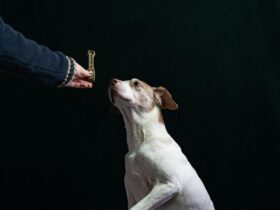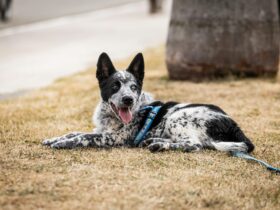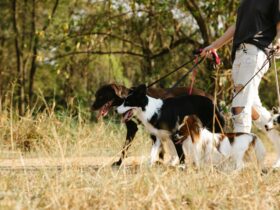Introduction
The COVID-19 pandemic brought significant changes to our lives, including how we work. For many, working from home became the new normal, allowing us to spend more time with our pets. As the world transitions back to the office, a new challenge arises: managing our dogs’ anxiety as they face being home alone again. This guide offers practical advice to help ease your dog’s anxiety during this transition.
Understanding Separation Anxiety in Dogs
Separation anxiety is a common issue where dogs experience stress when left alone. Symptoms can include excessive barking, destructive behavior, and even physical symptoms like vomiting. This anxiety often stems from the sudden change in routine, particularly after spending extended periods with their owners during the pandemic.
Signs of Separation Anxiety
- Excessive barking or howling: This often begins soon after you leave the house.
- Destructive behavior: Chewing furniture, scratching doors, or tearing up items.
- Pacing: Repetitive pacing, often in a fixed pattern, like back and forth or in circles.
- House soiling: Urinating or defecating indoors, even if house-trained.
- Escaping attempts: Trying to break out of the house or crate, often resulting in injury.
Preparing Your Dog for the Transition
Start Small: Gradual Absence Training
Begin by leaving your dog alone for short periods and gradually increase the duration. This method, known as gradual absence training, helps your dog become accustomed to being alone without triggering anxiety.
Steps for Gradual Absence Training:
- Short Absences: Start with 5-10 minute absences. Exit the house calmly without making a fuss.
- Increase Duration: Gradually extend your absences by 15-30 minutes at a time.
- Monitor Behavior: Use a pet camera to monitor your dog’s behavior when you’re away.
- Reward Calmness: Upon return, reward your dog if they remained calm during your absence.
Establish a Consistent Routine
Dogs thrive on routine, so maintaining a consistent schedule for feeding, walks, and playtime can reduce anxiety. Try to keep your workday routine similar to what it was during the pandemic to avoid sudden changes.
Daily Routine Tips:
- Morning Walk: A morning walk can help tire your dog out, making them more likely to rest while you’re away.
- Meal Times: Stick to regular feeding times. Consistency helps your dog feel secure.
- Interactive Play: Engage in interactive play sessions before leaving. A tired dog is more likely to relax.
Create a Safe and Comfortable Space
Designate a specific area in your home where your dog feels safe and comfortable. This could be a cozy corner with their bed, favorite toys, and some familiar scents.
Comfort Zone Essentials:
- Comfortable Bed: Choose a bed that supports your dog’s size and sleeping style.
- Favorite Toys: Provide toys that your dog loves and that stimulate their mind.
- Scented Items: Leave an item of your clothing in their space. Your scent can provide comfort.
Implementing Calming Techniques
Use of Calming Aids
Calming aids like pheromone diffusers, anxiety wraps, or natural supplements can help reduce your dog’s stress levels. These aids are often effective when combined with behavioral training.
Popular Calming Aids:
- Pheromone Diffusers: Release synthetic versions of calming pheromones.
- Anxiety Wraps: Provide gentle, constant pressure, similar to swaddling.
- Natural Supplements: Include ingredients like L-theanine, chamomile, or valerian root.
Desensitization to Departure Cues
Dogs often become anxious when they notice cues that you’re about to leave, such as putting on shoes or grabbing keys. Desensitizing your dog to these cues can reduce their anxiety.
Steps to Desensitize Departure Cues:
- Practice Cues Without Leaving: Pick up your keys or put on your shoes, then stay at home.
- Repeat Regularly: Repeat these actions multiple times a day without leaving.
- Mix Up Routines: Occasionally leave the house without typical cues to prevent your dog from associating them with your departure.
Enrichment Activities to Keep Your Dog Occupied
Keeping your dog mentally and physically stimulated can significantly reduce anxiety. Here are some activities to keep them occupied while you’re away.
Puzzle Toys and Treat Dispensers
Puzzle toys and treat dispensers are excellent for keeping your dog engaged. These toys challenge your dog’s mind and reward them with treats, providing both mental stimulation and positive reinforcement.
Recommended Puzzle Toys:
- KONG Classic: Fill with peanut butter or treats to keep your dog busy.
- Interactive Feeders: Slow down meal times by making your dog work for their food.
- Puzzle Boards: Engage your dog’s problem-solving skills with hidden treats.
Interactive Cameras
Interactive cameras allow you to check in on your dog while you’re away. Some models even let you dispense treats or speak to your dog, providing reassurance.
Top Interactive Cameras:
- Furbo Dog Camera: Features a treat dispenser and two-way audio.
- Petcube Bites 2: Offers treat dispensing, video streaming, and voice commands.
- WOpet Smart Pet Camera: Affordable option with treat dispensing and audio.
Dog Walkers and Pet Sitters
If your dog struggles with being alone, consider hiring a dog walker or pet sitter. Regular visits can break up the day and provide much-needed social interaction.
Choosing the Right Service:
- References: Look for recommendations from other pet owners.
- Meet and Greet: Arrange a meet-and-greet to ensure compatibility.
- Routine: Establish a consistent visit schedule.
Reinforcing Positive Behavior
Positive reinforcement is key to encouraging calm behavior when your dog is alone. Use treats, praise, and affection to reward your dog for staying calm and relaxed.
Reward Calm Behavior
When your dog remains calm during your absence or doesn’t react to departure cues, reward them immediately. Consistent positive reinforcement will help them associate being alone with good things.
Training Tips:
- Timing: Reward your dog as soon as you return, especially if they were calm.
- Use High-Value Treats: Offer treats that your dog loves but doesn’t get often.
- Stay Calm: Keep greetings low-key to avoid reinforcing anxious behavior.
Avoid Punishment
Punishing your dog for anxious behaviors like barking or destruction can increase their anxiety. Focus on positive reinforcement and training to address these behaviors constructively.
Alternative Approaches:
- Redirect Behavior: If your dog is anxious, redirect them to a toy or a calm activity.
- Ignore Attention-Seeking: Don’t reward anxious behavior with attention. Instead, wait for calm moments to engage with your dog.
When to Seek Professional Help
In severe cases, your dog’s anxiety may require professional intervention. If your dog’s anxiety leads to self-harm or severe behavioral issues, consult a veterinarian or a professional dog trainer.
Options for Professional Help:
- Veterinarian: Can rule out medical issues and may prescribe anti-anxiety medication.
- Certified Dog Trainer: Can provide personalized training plans for anxiety.
- Animal Behaviorist: Specializes in severe cases of anxiety and behavior modification.
Conclusion
Returning to the office post-pandemic is a big change for both you and your dog. With patience, consistency, and the right strategies, you can help ease your dog’s anxiety and ensure a smooth transition back to work. Remember, every dog is different, so it may take time to find the best approach for your furry friend. Your efforts will pay off in a happier, calmer dog who can confidently handle being home alone.











Leave a Reply